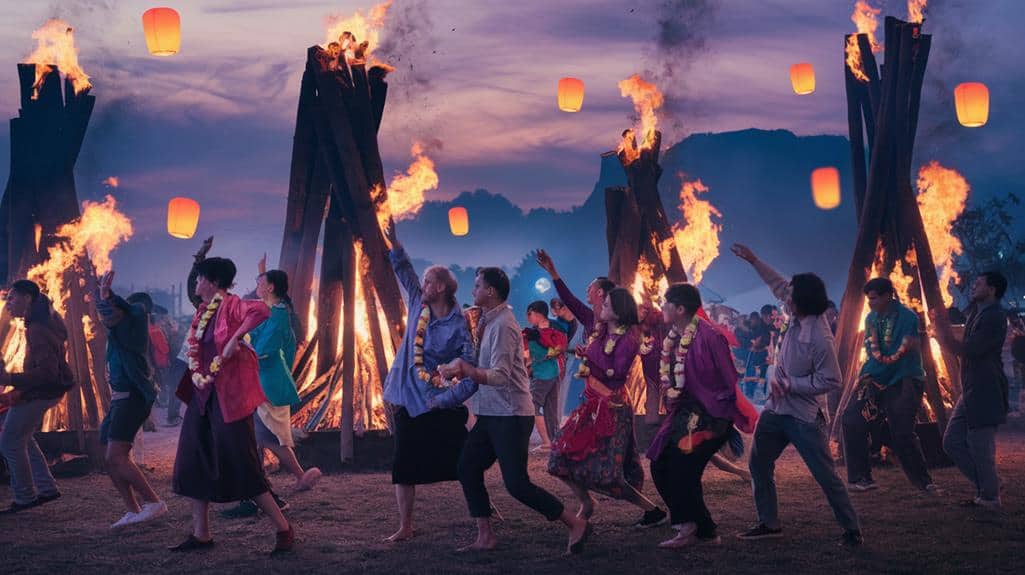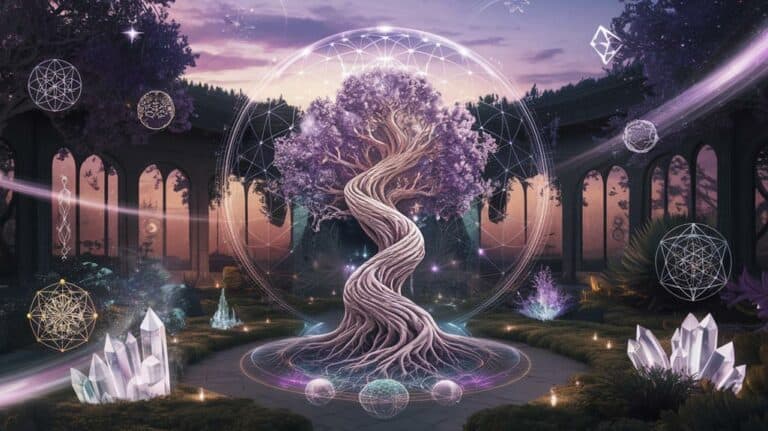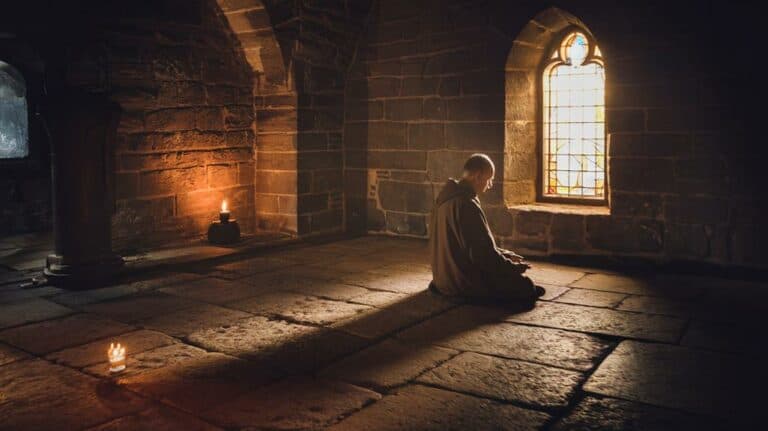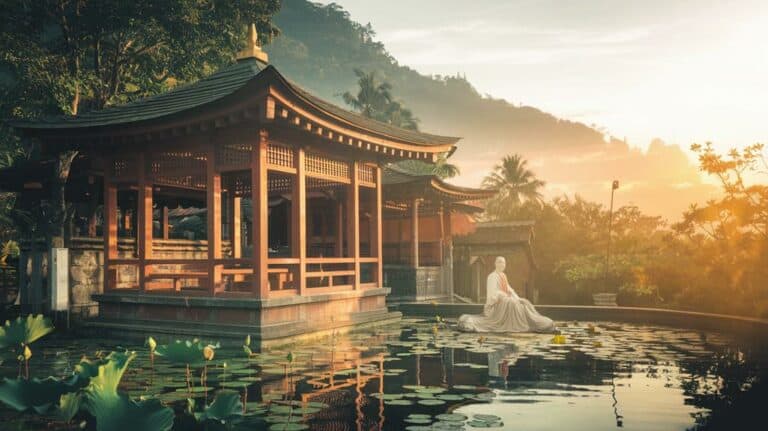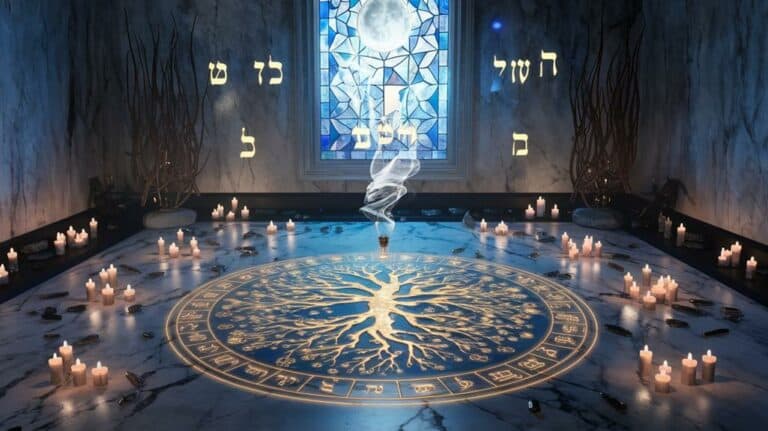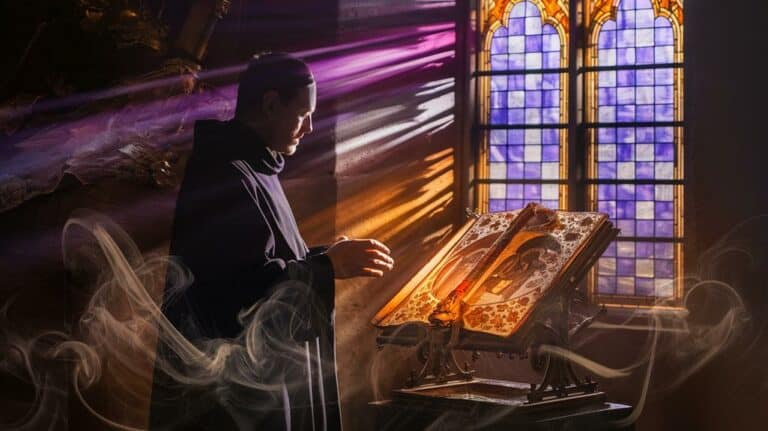15 Mystical Festivals Around the Globe
You’ll discover that mystical festivals offer far more than mere celebration—they’re gateways into humanity’s deepest spiritual connections. From the candlelit altars of México’s Día De Los Muertos to the floating lanterns of Thailand’s Yi Peng, these sacred gatherings bridge the gap between the physical and spiritual domains. Each festival carries its own unique rituals, yet they all share a common thread: the human desire to understand life’s greatest mysteries. As you explore these 15 remarkable celebrations, you’ll uncover ancient wisdom that continues to shape modern cultural identities and challenge our perceptions of existence itself.
Día De Los Muertos
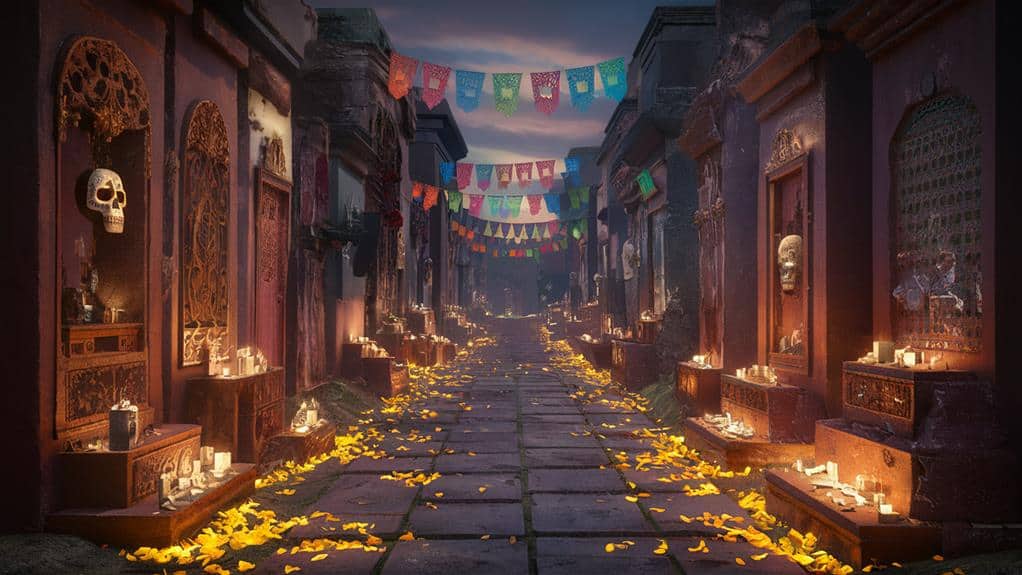
Celebration takes on a vibrant new meaning during Día De Los Muertos, Mexico’s iconic Day of the Dead festival. As you walk through candlelit streets, you’ll witness an extraordinary fusion of joy and remembrance, where the veil between the worlds of the living and the dead grows mysteriously thin.
You’ll find yourself surrounded by intricate altars adorned with marigolds, sugar skulls, and cherished photographs of departed loved ones. These ofrendas aren’t symbols of mourning but rather bridges connecting you to those who’ve crossed over.
The air fills with the sweet aroma of pan de muerto and copal incense, while paper papel picado flutters overhead like whispers from another domain.
You’re not merely observing death; you’re embracing it as an integral part of life’s endless cycle. In the face paint of La Catrina and the skeletal decorations, you’ll discover not macabre symbols but profound reminders of life’s impermanence.
This celebration invites you to confront mortality with open arms, transforming fear into understanding and grief into gratitude. It’s a reflection of humanity’s ability to find beauty and meaning in the deepest mysteries of existence.
Obon Festival
Countless lanterns illuminate Japan’s night sky during Obon, a centuries-old Buddhist festival honoring ancestral spirits. In this sacred time between worlds, you’ll witness how the boundary between the living and the dead grows thin, as families welcome back their departed loved ones for a brief but meaningful reunion.
You’ll find yourself drawn into the haunting melody of traditional folk songs as dancers move in synchronized circles during the Bon Odori, their movements telling stories of ancestors and homecoming. The air fills with the sweet scent of incense as temples ring their bells, each toll marking the path for wandering souls to find their way back.
At riverside ceremonies, you’ll join locals in releasing glowing lanterns onto the water, watching as they drift into darkness like a stream of stars returning to the heavens. These floating lights, each carrying prayers and remembrances, guide spirits back to their eternal rest.
In participating, you’ll understand how Obon transforms grief into celebration, reminding you that those who’ve passed remain forever connected through bonds that transcend mortality’s veil.
Chinese Ghost Festival
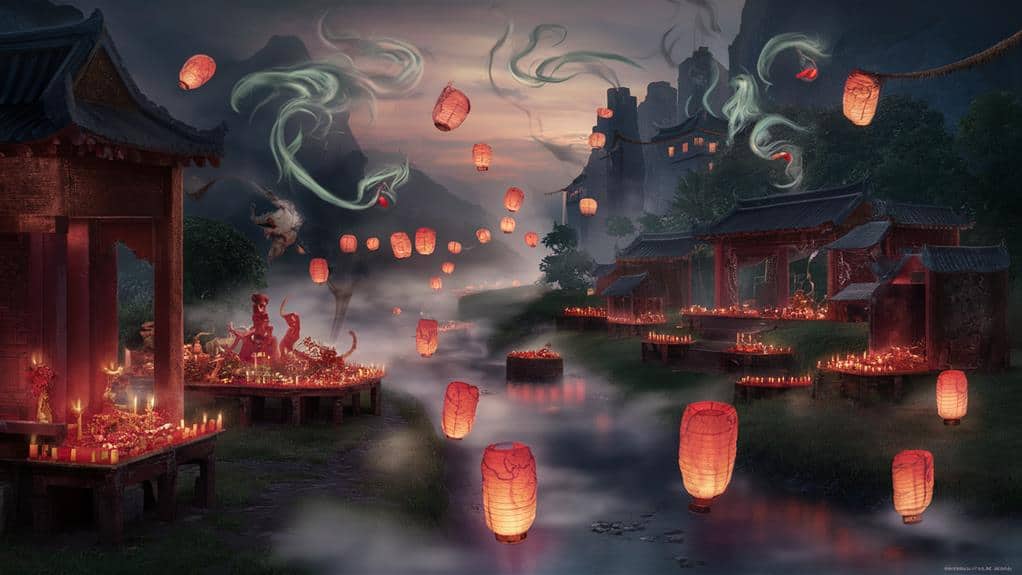
While Japan honors its ancestors during Obon, China’s Ghost Festival opens the gates between spheres during the seventh lunar month. You’ll find yourself caught in a mystical time when the boundaries between the living and the dead become permeable, allowing spirits to wander freely among mortals.
As lanterns illuminate the darkness, you’re participating in a tradition that’s persisted for over 2,000 years.
During this ethereal month, you’ll witness the burning of joss paper offerings – intricate replicas of worldly goods transformed into spiritual currency for your ancestors’ otherworldly needs.
You’ll join families as they place food offerings at altars and float lotus lanterns down rivers, each light representing a soul finding its way in the darkness.
The air fills with the sweet smoke of incense as monks chant sutras, creating a bridge between spheres.
You’re not just an observer but a participant in this cosmic dance of remembrance.
As you move through temples adorned with red lanterns, you’ll feel the weight of generations before you, understanding that you’re part of an endless cycle of spiritual connection and ancestral devotion.
Celtic Samhain
Ancient Ireland’s most important festival, Samhain marks the Celtic New Year when summer surrenders to winter’s embrace.
You’ll find yourself standing at the threshold between worlds as the veil between the living and the dead grows whisper-thin, allowing ancestral spirits to walk among you under October’s waning moon.
During Samhain, you’ll witness the sacred fires that once blazed across hilltops, as modern celebrants honor the ancient tradition of extinguishing all hearth flames before relighting them from a communal bonfire.
You’re participating in a timeless ritual where the darkness holds wisdom, and the boundaries between past and present dissolve like morning mist.
As you gather around these ceremonial flames, you’ll sense how your Celtic ancestors used this time for divination, seeking guidance from spirits who drift through the cosmic doorway.
The festival’s customs live on in today’s Halloween traditions, though you’ll find Samhain’s deeper essence in the quiet moments of reflection, when you’re contemplating the eternal cycle of death and rebirth.
It’s a time when you’re reminded that endings aren’t final but rather doorways to new beginnings.
Thai Yi Peng
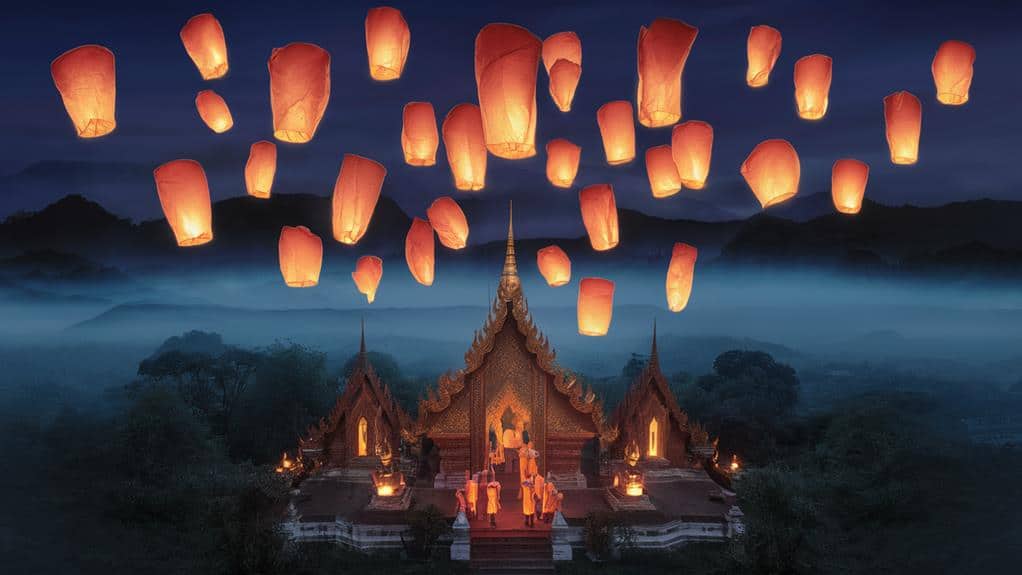
From Celtic bonfires illuminating the autumn night, we journey eastward to Thailand’s luminous Yi Peng festival, where thousands of lanterns paint the sky in a breathtaking display of light and hope.
As you stand beneath the Thai night sky during the full moon of the twelfth lunar month, you’ll witness the release of countless khom loi – delicate rice paper lanterns that carry wishes, prayers, and burdens skyward. Each lantern you release represents the letting go of misfortunes and the embrace of new beginnings, a profound act of spiritual cleansing that’s been practiced for centuries in the ancient Lanna kingdom.
You’ll find yourself among devoted locals and pilgrims at temples throughout Chiang Mai, where monks’ chants blend with the soft crackle of burning lanterns. The ritual isn’t merely about spectacle – it’s a deeply personal meditation on impermanence and renewal.
As your lantern joins the constellation of floating lights, you’re participating in a collective moment of release and aspiration. When thousands of illuminated vessels drift upward in unison, you’ll understand why Yi Peng represents humanity’s timeless desire to reach beyond earthly constraints toward something greater than ourselves.
Hindu Diwali
The Festival of Lights illuminates homes across India and beyond as Hindu families celebrate Diwali with dazzling diyas, intricate rangoli patterns, and jubilant gatherings.
You’ll witness a transformation as neighborhoods burst into radiance, with countless oil lamps and lanterns creating rivers of light that symbolize the triumph of good over evil, knowledge over ignorance.
During this sacred five-day celebration, you’ll find yourself drawn into ancient traditions that connect you to generations past.
As you light each diya, you’re participating in rituals that honor Lakshmi, the goddess of prosperity and wisdom.
You’ll see doorways adorned with marigold garlands and floors decorated with colored rice powder, creating geometric patterns that serve as sacred welcome mats for divine blessings.
The evening air fills with the crackling of fireworks and the sweet aroma of traditional delicacies, while families exchange gifts and prayers.
In these moments, you’ll understand how Diwali transcends mere festivity – it’s a profound reminder of your inner light, calling you to illuminate the darkness within and around you, connecting your spirit to the eternal cycle of renewal and hope.
African Famadihana
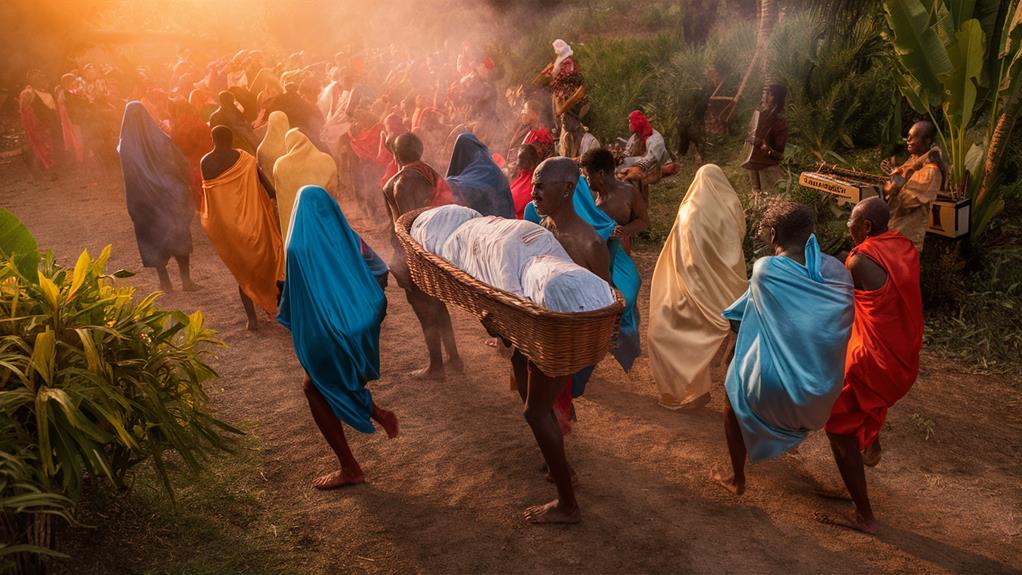
While Diwali celebrates light and new beginnings, Madagascar’s Famadihana honors endings and remembrance in a uniquely joyful way.
In this profound “turning of the bones” ceremony, you’ll witness families exhuming their ancestors’ remains every five to seven years, wrapping them in fresh silk shrouds, and dancing with them to live traditional music.
You’ll find yourself immersed in a celebration where the boundary between life and death dissolves, as relatives share stories of their departed loved ones while feasting on zebu meat and rice.
The scent of rum mingles with perfume as you observe family members sprinkling their ancestors’ remains with wine and fragrance, believing this keeps the spirits content until the next ceremony.
What you’re experiencing isn’t mourning in the traditional sense – it’s a powerful affirmation of the eternal bond between the living and the dead.
As you watch the procession of wrapped bodies held high, moving to the rhythm of flutes and drums, you’ll understand how this ancient Malagasy tradition transforms what Westerners often view as taboo into a sacred celebration of eternal family connections.
Scottish Hogmanay
Midnight bonfires illuminate Scotland’s ancient streets as Hogmanay transforms ordinary towns into magical spaces of celebration each New Year’s Eve.
You’ll find yourself swept into the heart of this mystical tradition, where fire becomes a symbol of purification and renewal, casting dancing shadows on stone walls that have witnessed centuries of revelry.
As you join the torch-lit processions winding through Edinburgh’s cobbled lanes, you’re participating in a ritual that predates written history.
The thunderous “first-footing” tradition beckons you to cross thresholds bearing gifts of whisky and coal, becoming the first visitor of the year in homes that open their doors to fortune’s embrace.
You’ll hear ancient Gaelic songs carried on winter winds, their melodies weaving together past and present in a tapestry of cultural memory.
What sets Hogmanay apart isn’t just its scale but its profound connection to Scotland’s pagan roots, where you’ll discover that each ritual – from the swinging of fireballs in Stonehaven to the haunting verses of “Auld Lang Syne” – serves as a bridge between worlds, marking time’s eternal passage while celebrating humanity’s enduring spirit.
Hungry Ghost Festival
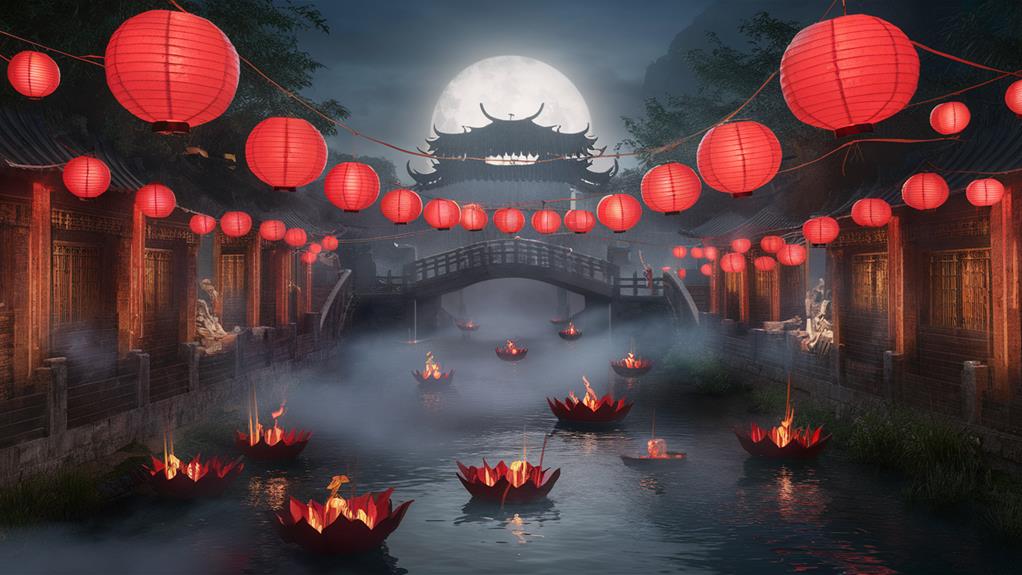
Across Eastern Asia, ancestral spirits drift back to Earth during the seventh lunar month, marking the ethereal Hungry Ghost Festival. You’ll witness streets illuminated by paper lanterns and incense smoke curling into the night sky, as families honor their deceased relatives through ancient rituals that bridge the mortal and spiritual domains.
During this sacred period, you’re called to acknowledge those who’ve passed before you, setting out elaborate feasts and burning joss paper offerings – symbolic items that transform into real possessions in the afterlife.
You’ll notice empty seats at outdoor performances, reserved for unseen spectators, while monks chant sutras that echo through temple courtyards.
As you navigate this liminal time, you’ll find yourself contemplating the delicate balance between reverence and caution. It’s believed that wandering spirits seek sustenance and entertainment among the living, reminding you of life’s impermanence and the enduring connections that transcend death.
Through these observances, you’re participating in a profound tradition that acknowledges both the light and shadow of existence, where the boundaries between worlds grow thin and sacred remembrance takes center stage.
Bhutanese Tshechu
In the remote Himalayan kingdom of Bhutan, you’ll find celebrations that shift from solemn ancestral reverence to vibrant displays of masked dance and spiritual devotion.
The Tshechu, meaning “tenth day,” transforms monastery courtyards into sacred theaters where ancient Buddhist stories unfold through intricate choreography and symbolic gestures.
As you witness these centuries-old rituals, you’ll discover that each masked dance carries profound spiritual significance.
The whirling cham dancers, adorned in colorful brocade robes and hand-carved wooden masks, become living embodiments of protective deities and enlightened beings. Their movements tell tales of triumph over evil, spiritual liberation, and the eternal cycle of existence.
You’ll join local Bhutanese who’ve traveled for days to receive blessings and accumulate merit for their next life.
The festival’s crescendo arrives with the unfurling of the massive thongdrel, a sacred tapestry that’s believed to cleanse sins through mere viewing.
As dawn breaks over the dzong’s ancient walls, you’ll feel the collective energy of thousands of devotees, each seeking their own path to enlightenment through these mystical celebrations that bridge the earthly and divine spheres.
Galungan Festival
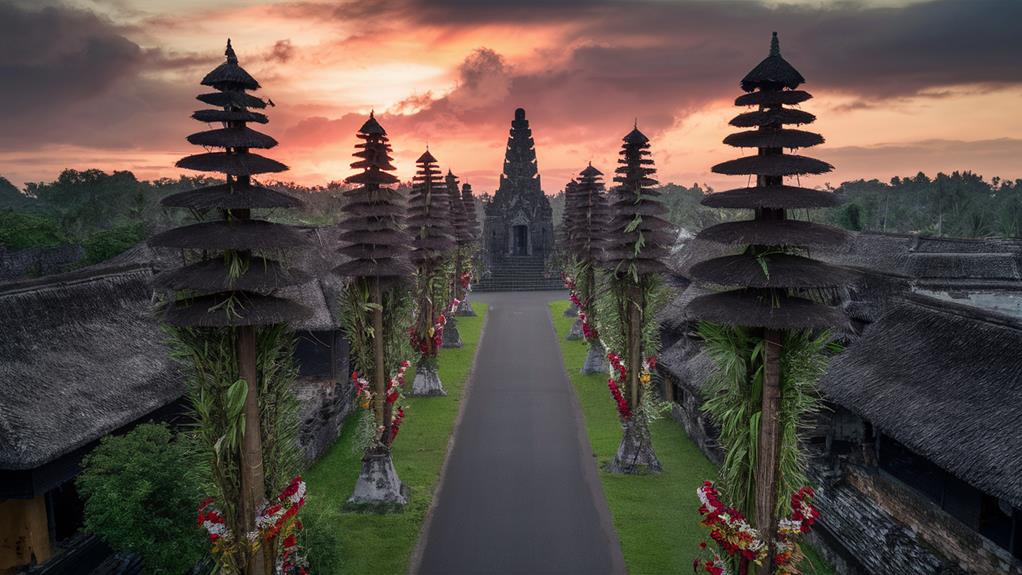
Life springs into action on the Indonesian island of Bali during Galungan, a vibrant 10-day festival celebrating the triumph of good over evil.
You’ll find yourself immersed in a world where ancestral spirits descend to Earth, as elaborate bamboo poles called penjor arch gracefully over the streets, their offerings swaying in the warm tropical breeze.
Throughout the island, you’ll witness families crafting intricate offerings of fruit, flowers, and rice cakes, while traditional gamelan music echoes through ancient temple courtyards.
Your senses will awaken to the aroma of burning incense and the sight of women in vibrant ceremonial dress carrying towering arrangements upon their heads.
In homes and temples, you’ll observe prayers and rituals that bridge the physical and spiritual domains, connecting you to centuries of Balinese Hindu tradition.
As you move through this sacred time, you’ll notice how the boundaries between the seen and unseen worlds dissolve.
The festival’s culmination, Kuningan, marks the ancestors’ return to their celestial sphere, leaving you with profound insights into the delicate balance between darkness and light, mortality and divinity.
Karthikai Deepam
Every November, millions of oil lamps illuminate Tamil Nadu as devotees celebrate Karthikai Deepam, a festival of lights honoring Lord Shiva‘s manifestation as an infinite pillar of fire.
You’ll find yourself drawn to the mesmerizing glow of earthen lamps that line the streets, homes, and temples, each flame representing the divine light that dispels darkness from your consciousness.
As you witness the grand celebrations at the Arunachaleswarar Temple in Thiruvannamalai, you’ll understand why this sacred beacon holds such profound significance.
The massive lamp atop the holy hill burns for three days, visible for miles around, serving as a cosmic reminder of your own inner light.
Throughout the region, you’ll observe devotees performing the ritualistic lighting of lamps while reciting ancient mantras, connecting to a tradition that’s survived millennia.
You’re experiencing more than just a festival; you’re participating in a transformative ritual where fire becomes a bridge between the earthly and divine.
In these moments, as you join countless others in lighting your own lamp, you’ll feel an inexplicable connection to both the eternal flame within and the collective spiritual consciousness that binds humanity together.
Walpurgis Night
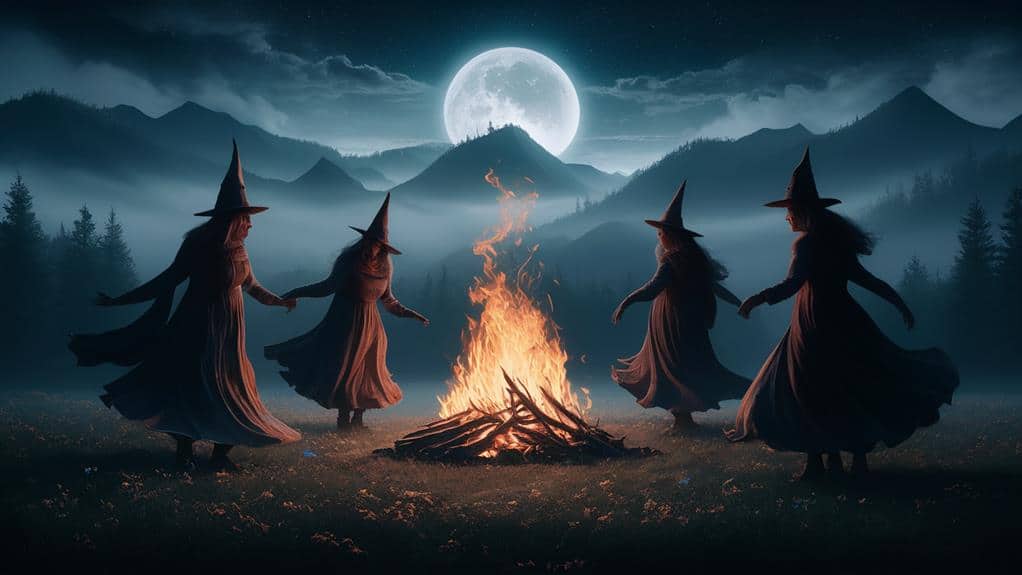
Deep within the heart of Central and Northern Europe, Walpurgis Night erupts each April 30th with blazing bonfires and ancient pagan rituals.
You’ll find yourself drawn into a domain where the veil between worlds grows thin, as communities gather to ward off dark spirits and welcome the arrival of spring. Like your ancestors before you, you’ll feel the primordial pull of the festivities that mark this threshold between winter’s death and summer’s rebirth.
As you stand before the towering bonfires, you’ll witness how modern celebrants honor the legacy of Saint Walburga while embracing the night’s older, deeper roots in Germanic folklore.
You’ll hear ancient songs carried on the wind as dancers move in circles, their shadows merging with the spirits of the wild hunt.
In Sweden, you’ll discover how the celebration transforms into Valborg, where choirs greet the season with traditional spring songs, while in Germany’s Harz Mountains, you’ll encounter elaborate performances of legendary witches’ gatherings atop Brocken Mountain.
This night reminds you that within every modern celebration lies an ancient truth: the eternal dance between darkness and light, winter and spring, death and renewal.
Ghost Month Taiwan
Burning incense fills Taiwan’s streets each seventh lunar month, as the gates of the spirit world swing open for Ghost Month.
You’ll find yourself traversing a transformed landscape where the boundaries between the living and the dead blur, as wandering spirits return to seek comfort, nourishment, and connection with their descendants.
During this ethereal period, you’re called to honor both your ancestors and the hungry ghosts who’ve lost their way.
You’ll notice how residents place elaborate offerings of fresh fruit, incense, and spirit money outside their homes and businesses, creating a bridge between dimensions.
The night air carries the sound of chanting monks and traditional opera performances, staged to appease restless spirits.
You’ll learn to move mindfully through this sacred time, avoiding activities that might attract unwanted spiritual attention.
Don’t whistle after dark, swim in open waters, or move into new homes – these boundaries must be respected.
As you witness the burning of joss paper and the releasing of water lanterns, you’re participating in an ancient tradition that acknowledges life’s profound mysteries and our eternal connection to those who’ve crossed over.
Festival of Souls
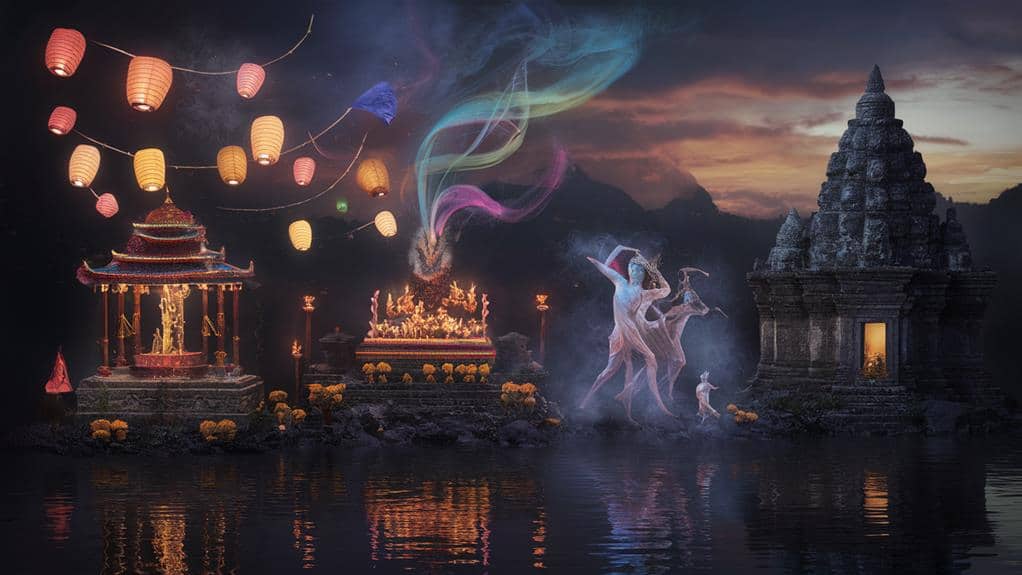
Throughout Mexico’s sun-drenched cities and villages, the Festival of Souls (Día de los Muertos) transforms streets into vibrant celebrations of life and death each November.
You’ll witness altars adorned with marigolds, sugar skulls, and cherished photographs of departed loved ones, as the veil between worlds grows thin. The scent of copal incense drifts through narrow alleyways, guiding spirits back to embrace their living relatives.
As you walk among the candlelit ofrendas, you’ll discover a profound truth: death isn’t meant to be feared but understood as life’s natural companion.
You’ll see families sharing pan de muerto while recounting stories of those who’ve passed, their laughter mixing with the sounds of mariachi bands playing beloved songs.
In cemeteries, you’ll find graves transformed into works of art, decorated with papel picado and personal treasures.
This celebration teaches you that grief and joy can coexist, that remembrance is an act of love, and that death doesn’t sever our connections to those we’ve lost.
The Festival of Souls reminds you that our ancestors continue to shape our present, their stories woven into the fabric of our existence.



